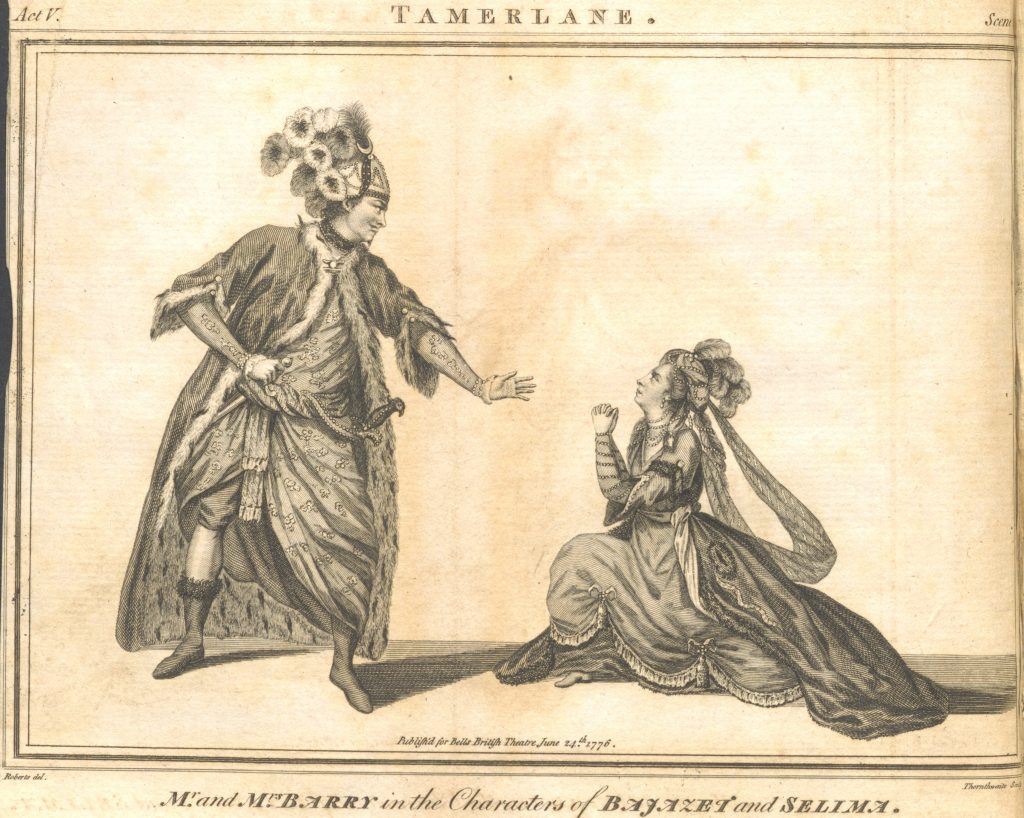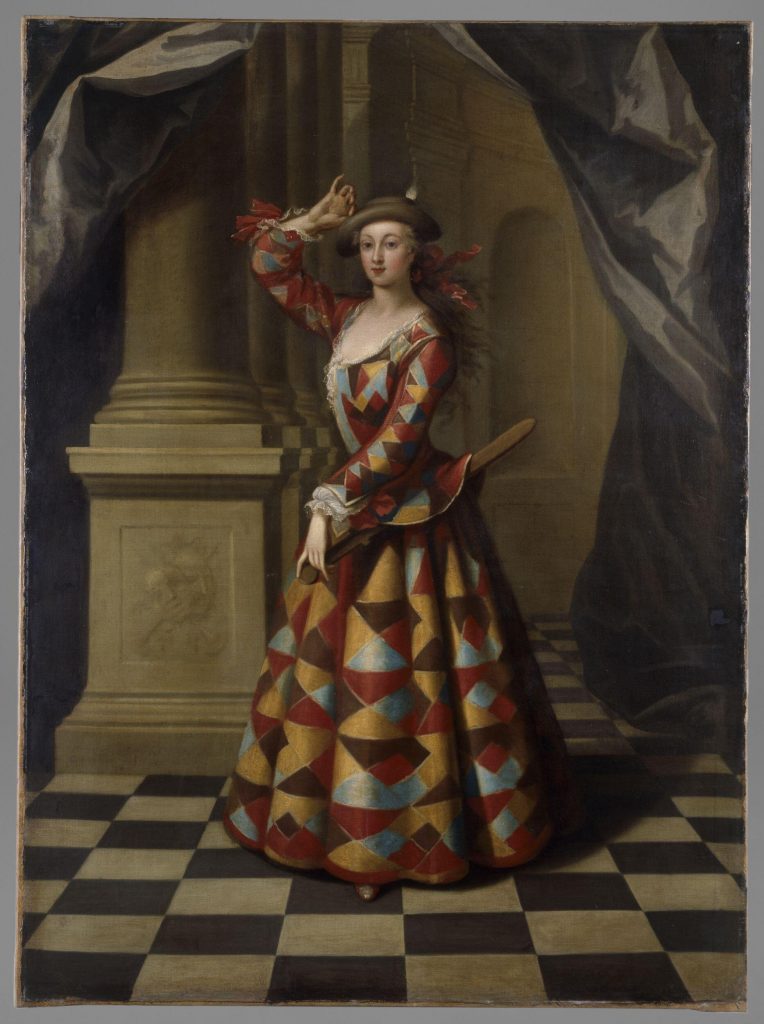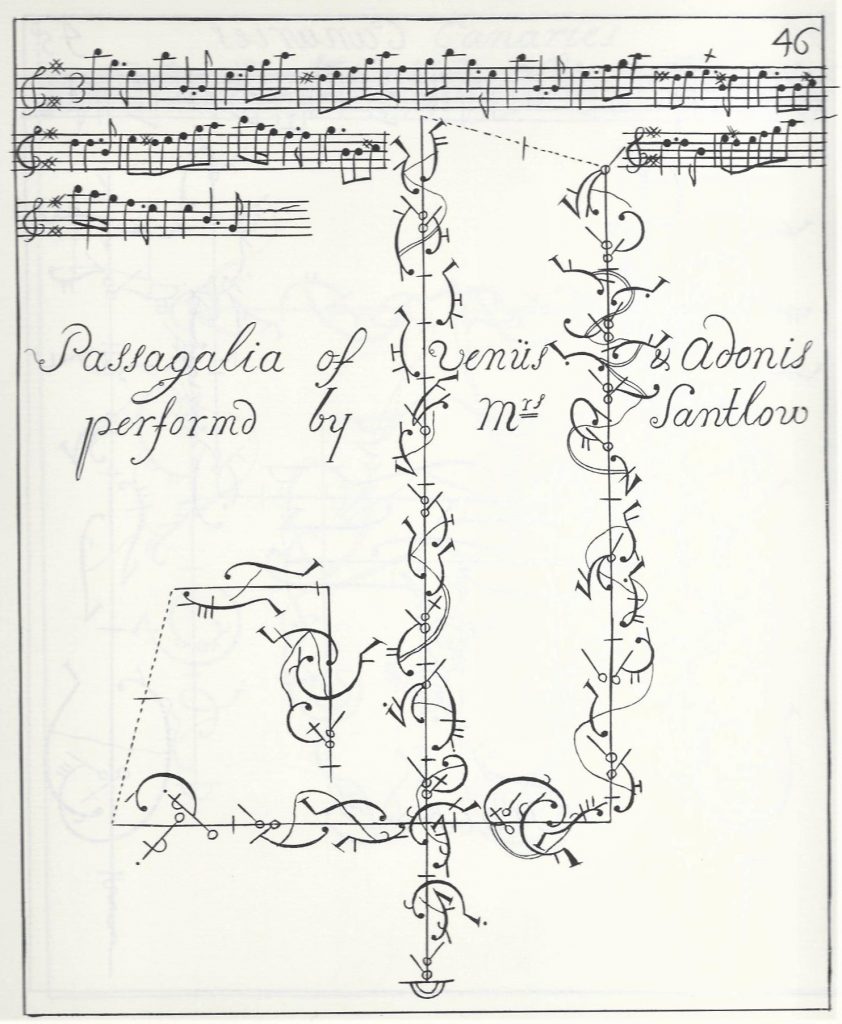By Moira Goff
In An Essay towards an History of Dancing, John Weaver had described Scenical Dancing as ‘a faint Imitation of the Roman Pantomimes’.1 In his scenario for The Loves of Mars and Venus, he explained the accomplishments of these performers from classical antiquity to his audience:
… these Mimes and Pantomimes were Dancers that represented a Story or Fable in Motion and Measure: They were Imitators of all things, as the Name of Pantomime imports, and perform’d all by Gesture and the Action of the Hands, Fingers, Legs and Feet, without making use of the Tongue. The Face or Countenance had a large Share in this Performance, and they imitated the Manners, Passions, and Affections, by the numerous Variety of Gesticulations.
Weaver went on to refer to the ‘Rules of the Drama in their mute Performances’ and to their ‘confining each Representation to a certain Action, with a just Observation of the Manners and Passions, which that Action naturally produced.’2
These quotations provide clues to the skills he prized in Hester Santlow, who he elsewhere praised as
a Dancer … where Art and Nature have combin’d to produce a beautiful Figure, allow’d by all Judges in our Art to be the most graceful, most agreeable, and most correct Performer in the World.3
Weaver surely needed little persuading that she was a performer who had a mastery of the ‘Force and Beauty of graceful Motion, and handsome Gesture’ – skills that were the foundation of Scenical Dancing.4
There are two scenes in The Loves of Mars and Venus for which Weaver prescribes specific gestures: scene two in which Venus and Vulcan perform a ‘Dance being altogether of the Pantomimic kind’; and scene six in which Mars, Venus and Vulcan express a series of Passions as Vulcan enjoys his revenge. In both Weaver builds the action around the contrasting gestures of Venus and Vulcan.
In scene two, the passacaille is succeeded by ‘a wild rough Air’ and the Graces and Cupid run off leaving Venus alone on stage. The scene takes on a very different atmosphere:
Enter to Venus, Vulcan: They perform a Dance together; in which Vulcan expresses his Admiration; Jealousie; Anger; and Despite: And Venus shews Neglect; Coquetry; Contempt; and Disdain.
This is the dance ‘of the Pantomimic kind’. On the following pages of the scenario, Weaver describes the gestures used by Vulcan and Venus. There are nine for Vulcan, expressing more powerful and varied Passions than the five for Venus, which are mainly variations on the theme of rejection. Put together, they show the progress of this mute argument, which begins with Vulcan’s Admiration of his beautiful wife and ends with a gesture of Detestation towards him by Venus as she leaves the stage.5 The pair could have moved through some conventional dance figures and even performed some steps with their successive gestures, although the music would surely not have conformed to a particular dance type.
Scene six brings Weaver’s ‘Dramatick Entertainment of Dancing’ to a conclusion as Vulcan exacts his revenge on his wife and her lover and their fellow deities enter as witnesses:
Vulcan shews them his Prisoners. Shame; Confusion; Grief; and Submission, are discover’d in the Actions of Venus; Audacity; Vexation; Restlessness; and a kind of unwilling Resignation; in those of Mars. The Actions of Vulcan, are of Rejoicing; Insulting; and Derision.
None of Vulcan’s actions are included among the gestures described on the last page of the scenario, although the Shame, Grief and Submission of Venus are there. Here, the three leading characters probably performed their actions and gestures simultaneously without really moving round the stage, until Neptune persuades Vulcan to forgive Venus and Mars and they are reconciled before the final Grand Dance.6
Weaver apparently drew on John Bulwer’s rhetorical treatises Chirologia and Chironomia, first published together in 1644, although this source seems to have been overlooked by researchers.7 Rhetoric, of course, provides a link to acting. Another such link is Charles Gildon’s The Life of Thomas Betterton published in 1710, which refers to some of the gestures described by Weaver.8
As an actress as well as a dancer, Hester Santlow would have been familiar with many of the gestures that Weaver describes. During the 1716-1717 season, she played 21 different acting roles (the majority of which were in comedies) and among them were 14 roles that she kept throughout her acting career. Her ‘line’ in tragedy was the pathetic heroine, such as Ophelia in Shakespeare’s Hamlet and Selima in Rowe’s Tamerlane, both plays were staples of the repertoire. In comedy, she was often cast as the young, witty heroine, for example Harriet in Etherege’s The Man of Mode and Angelica in Farquhar’s The Constant Couple. These roles, in particular, provide clues to her representation of Venus in Weaver’s The Loves of Mars and Venus. It is worth noting that both Selima and Harriet had earlier been played by the singer-actress Anne Bracegirdle, who had acted and sung Venus in Motteux’s The Loves of Mars and Venus. Motteux’s masque was one of Weaver’s sources for his ballet and he may well have seen Mrs Bracegirdle as Venus.9
Etherege’s The Man of Mode provides some hints towards Mrs Santlow’s performance of Venus’s ‘Coquetry … seen in affected Airs, given her self throughout the whole Dance’.10 In the first scene of act three, Harriet and Young Bellair feign courtship and he advises her how to behave:
At one motion play your Fan, roul your Eyes, and then settle a kind look upon me.
…
Now spread your Fan, look down upon it, and tell the Sticks with a Finger.
…
Clap your hand up to your bosom, hold down your Gown. Shrug a little, draw up your Breasts and let ‘em fall again, gently, with a Sigh or two,
…
Clap your Fan then in both your hands, snatch it to your Mouth, smile, and with a lively motion fling your Body a little forwards. So—now spread it; fall back on the sudden, cover your Face with it, and break out into a loud Laughter—take up! Look Grave, and fall a fanning yourself—11
Such a sequence, practised when she played Harriet, provided a store of actions that Hester Santlow could draw on for the Coquetry of Weaver’s Venus.
There are very few illustrations of actors and actresses in performance before the late 18th century, so it is difficult to demonstrate visually a link between Weaver’s gestures and Mrs Santlow’s acting skills. Frontispiece illustrations to plays developed significantly when John Bell began to publish Bell’s British Theatre from 1776.12 Among the plates made to accompany Bell’s editions are two that suggest the continuity of the conventions governing gestures. One shows Ann and Spranger Barry as Selima and Bajazet in Nicholas Rowe’s Tamerlane.

The scene is from act five and Mrs Barry as Selima is suing for mercy.13 The other shows Mrs Hartley in the title role of Rowe’s Jane Shore.14 Hester Santlow never appeared in the play, but Mrs Hartley’s gesture, from act four, is recognisably Weaver’s Detestation which he describes as a ‘more passionate Form’ and a ‘redoubled Action’ in which ‘both the turn’d-out Palms are so bent to the left side, and the Head still more projected from the Object’.15

Gestures similar to Weaver’s can also be found in Gilbert Austin’s Chironomia published in London in 1806. For example, he describes and depicts Shame which ‘in the extreme sinks on the knee and covers the eyes with both hands’ and ‘Mild resignation’ which ‘falls on the knee, crosses the arms on the breast, and looks forwards and upwards to heaven’, adding in both cases that he is showing a ‘feminine expression’ of the Passion.16 Writing some 90 years after Weaver, it is reasonable to assume that Austin is referring to conventions that had changed significantly. Yet, there are enough resemblances within his gestures between Austin’s gestures, those that can be seen in 18th-century depictions of actors and Weaver’s descriptions to suggest a continuous tradition. Austin’s mention of the ‘feminine expression’ of particular Passions opens the possibility that Hester Santlow used her own conventions of gesture, from her work as an actress, in The Loves of Mars and Venus. The action in John Weaver’s ‘Dramatick Entertainment of Dancing’ may have owed more to her than we can ever know.
NOTES
1) John Weaver, An Essay towards an History of Dancing (London, 1712), p. 168. All of Weaver’s published works are reproduced in facsimile in Richard Ralph, The Life and Works of John Weaver (London, 1985), to which references will also be given. For this quotation see p. 665.
2) John Weaver, The Loves of Mars and Venus (London, 1717), pp. x-xi. Ralph, John Weaver, pp. 739-740.
3) John Weaver, Anatomical and Mechanical Lectures upon Dancing (London, 1721), p. x. Ralph, John Weaver, p. 869.
4) Weaver, Loves of Mars and Venus, p. xi. Ralph, John Weaver, p. 740.
5) Weaver, Loves of Mars and Venus, pp. 20-23. Ralph, John Weaver, pp. 752, 754-756.
6) Weaver, Loves of Mars and Venus, pp. 27-28. Ralph, John Weaver, pp. 760, 762.
7) John Bulwer, Chirologia: or the naturall language of the hand … whereunto is added Chironomia: or, the art of manuall rhetoricke (London, 1644). Studies of Bulwer’s treatises have focussed on the influence of his sign language in the teaching of deaf people, they await detailed scrutiny by historians of acting as well as dancing.
8) See Ralph, John Weaver, pp. 135-136 for Gildon and Weaver’s Essay.
9) For Mrs Santlow’s acting repertoire in relation to The Loves of Mars and Venus see Moira Goff, ‘In pursuit of the dancer-actress’, in Women’s work: making dance in Europe before 1800, ed. Lynn Matluck Brooks (Madison, Wis., 2007), 183-204 (pp. 191-194).
10) Weaver, Loves of Mars and Venus, p. 22. Ralph, John Weaver, p. 755.
11) George Etherege, The Man of Mode (London, 1676), pp. 35-36.
12) See Judith Milhous and Robert D. Hume, The publication of plays in London 1660-1800 (London, 2015), chapter 6.
13) Nicholas Rowe, Tamerlane (London, 1776)
14) Nicholas Rowe, Jane Shore (London, 1776)
15) Weaver, Loves of Mars and Venus, p. 23. Ralph, John Weaver, p. 756.
16) Gilbert Austin, Chironomia (London, 1806), p. 489, figures 108, 109.
IMAGES
- James Roberts (artist) and John Thornthwaite (engraver), frontispiece plate from Nicholas Rowe, Tamerlane (London, 1776) in Bell’s British Theatre, vol. 31. Copy courtesy of Special Collections and Archives, Queen’s University Belfast.
- James Roberts (artist), frontispiece plate from Nicholas Rowe, Jane Shore (London, 1776), in Bell’s British Theatre, vol. 1. ©Victoria & Albert Museum.
NEXT POST
The next post, on Clarissa Wybrow (née Blanchet), is by Keith Cavers and will appear on 10th December 2021.

